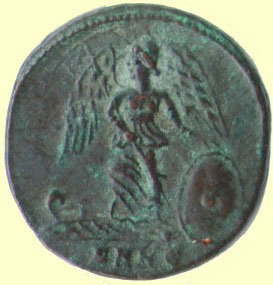 Contents -
Previous Article -
Next Article
Contents -
Previous Article -
Next Article
The Constantinopolis commemorative was struck to commemorate Constantine's new capital of Constantinopolis or Constantinople, as it came to be known by Europeans. Constantinopolis soon became the largest and most important city in the late classical and early medieval world west of China. The coins were issued from AD 330 until 346. The reverse depicts a figure of Victory standing with her foot on the prow of a ship, while the helmeted head of a female figure personifying the city graces the obverse of this type. These types were a circulating commemorative much like the Bicentennial coinage struck in the United States in 1976. Dealers usually have one or more of these in either their stock boxes or junk box at quite reasonable prices. the example depicted here cost about thirty five dollars, which is on the high end of the price range for these types. The beautiful blue - green patina is what made this a thirty five dollar coin instead of a ten dollar coin.
Return to Fourth Century Roman Bronze Table of Contents - This topic table of contents.
Return to Roman Coins Table of Contents - Up one level.
Return to History and Technology Back Pages - The home page for this entire site.
Identifying Common Fourth Century Roman Bronze Coins
Reading the Emperor's Name and Titles
A Picture Gallery of Fourth Century Reverse Types
Camp Gate
Altar Inscribed VOTIS XX
Two Soldiers Standing With Two Standards
Two Soldiers Holding One Standard
Wreath With Legend Inside
Soldier Spearing a Fallen Horseman
VRBS ROMA Commemorative - Mother Wolf Suckling Twins Romulus and Remus
CONSTANTINOPOLIS Commemorative - Victory Standing on Prow of Ship
Two Victories Each Holding a Small Wreath
Two Victories Each Holding a Large Wreath on Centenionals of Decentius
Emperor Holding Labarum or Standard and Dragging Captive
Emperor Raising Kneeling Captive
Victory Advancing Left
A Key to Fourth Century Inscriptions
Some Scarcer Late Fourth Century and early Fifth Century Types